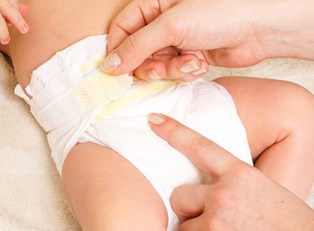Diaper rash is a common ailment that is experienced by infants. Visually, most rashes appear quite similar, but distinguishing between a common rash and a yeast infection is crucial for treating the condition properly. Vigilant diaper changing is usually enough to stave off most occurrences, but even the most attentive parents will encounter an occasional bout of diaper rash with their babies.
Diaper Rash Causes
Rashes that are not caused by a colonization of yeast can be caused by a variety of reasons. The skin appears red and can sometimes be raw and bleeding. Pimples may appear and may or may not be filled with pus. The skin may become ulcerated and blisters sometimes form. Irritation in the diaper area is often caused by a reaction between ammonia in urine and fecal bacteria. Children who have frequent stools are more likely to develop this type of rash due simply to exposure of the two offending elements.
As new foods are added to the infant's diet, the change in fecal composition can also cause an irritation to the baby's sensitive skin. Some infants with particularly sensitive skin can develop diaper rash from scented wipes, laundry detergent, lotion, and some brands of disposable diapers. Diaper rashes can also be caused by diapers that are too tight and chafe against the skin.
Diaper Rashes and Yeast Infections
Diaper rash is also commonly caused by a yeast infection. Yeast thrives in a warm, moist environment, which makes the diaper area a perfect place for it to grow. The use of antibiotics in the infant (or in the mother if she is breastfeeding) can stimulate growth of yeast in the diaper area. Antibiotics kill good bacteria along with the bad, which leaves an open breeding ground for yeast to flourish.
Diaper rash caused by yeast begins to form in the creases of the skin, on the genitals and the thighs. This type of rash does not usually form on the buttocks. It is often difficult to determine whether or not a diaper rash is caused by yeast, and consulting with your child's pediatrician can be beneficial. Once a yeast infection has progressed, you will be able to notice telltale signs, such as slightly raised borders, lesions that branch of close to the affected area, and the fact that yeast infections don't respond to regular treatments for diaper rashes.
Treating Rashes and Infections
It is important to determine the cause of diaper rash, so it can be treated properly. Diaper rashes caused by yeast are treated with antifungal creams, while other rashes require an antibiotic cream or steroid applications. Parents and caregivers can speed up the healing process for any type of diaper rash by using practical methods that are easy to do at home. The skin is very sensitive, so it is important not to scrub it during diaper changing. Using a soft cloth or cotton balls to gently wipe the area will reduce trauma to the delicate skin. Changing the baby as soon as the diaper is wet and soiled will also help quicken the healing process. Exposing the baby's skin to light and air is also an excellent way to speed recovery. Diaper rashes can be frustrating, but identifying the rash for proper treatment and diligent care can help quicken the healing process.



